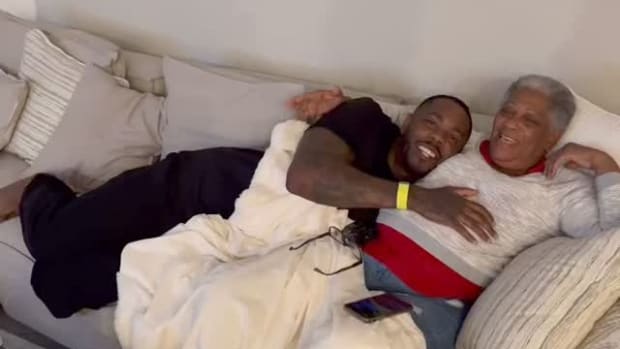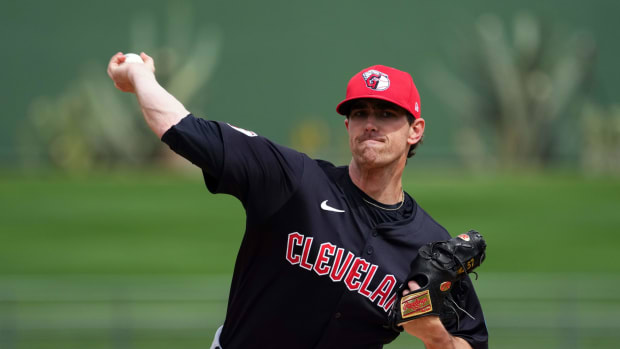Building the Best Red Sox Team for 2023
Editors’ Note, Wednesday, Nov. 23 at 1:37 p.m. ET: The Red Sox signed left-handed reliever Joely Rodríguez to a one-year contract, reportedly worth $2 million, with a club option for 2024. This story has been updated to include the deal.
The pressure is on for a splashy hot stove season in Beantown. Three seasons of Chaim Bloom leading the Red Sox front office has yielded one playoff appearance, a run in 2021 from the wild-card game to the ALCS. Bloom’s predecessors, Dave Dombrowski and Ben Cherington, were fired by the end of Year 4 despite each winning a World Series.
That seemingly sets up next season as the make-or-break campaign of Bloom’s tenure. Boston could either qualify for the playoffs and give the appearance of a team on the up and up or fail to take advantage of an expanded postseason field and almost certainly doom Bloom to a pink slip.
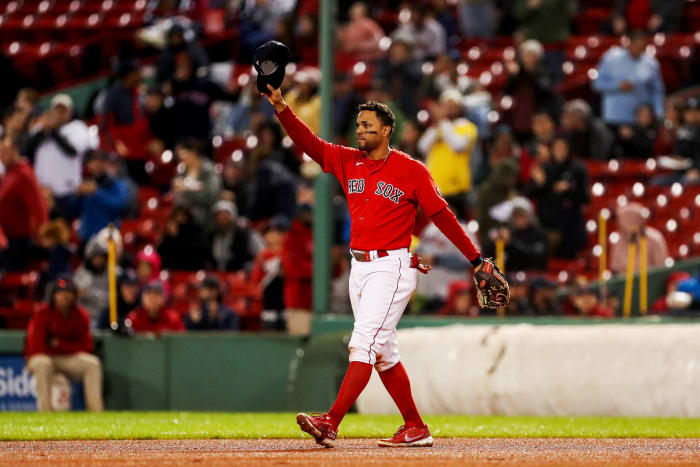
Shortstop Xander Bogaerts, who has spent his entire career with the Red Sox, is a free agent and has plenty of suitors. Boston needs to find a way to replace his production if he signs elsewhere.
Paul Rutherford/USA TODAY Sports
This isn’t exactly an easy job right now, as the Red Sox play in MLB’s most competitive division. Over the last 11 years, they have made the playoffs five times and won two championships. They’ve also finished in last place in the AL East five times (including twice in the last three seasons under Bloom). But it’s certainly easier to win in Boston than it is with the Rays, the team with which Bloom made a name for himself as a young executive and which has continued to succeed without him. Given the resources at his disposal in overseeing one of the sport’s richest franchises, Bloom hasn’t met expectations. Let’s see what he could do this offseason to convince Boston’s ownership that the team is on the right track.
Unfortunately for the Red Sox, Bloom’s attempt to keep them competitive over the summer may have hamstrung their ability to bump next year’s payroll as high as many would like to see it. By adding veterans Tommy Pham and Eric Hosmer at the trade deadline, even after shedding Christian Vázquez’s salary by trading the catcher to the Astros, the Red Sox ended up a hair over the luxury tax threshold. While the taxes cost less than $1 million, the classification of Boston as a luxury tax team subjects the Red Sox to penalties for signing free agents who declined a qualifying offer before entering free agency—aka, the best ones—and will receive reduced compensation if either of their players who rejected a qualifying offer (Xander Bogaerts, Nathan Eovaldi) sign with another team. Those penalties would only worsen with another year above the luxury tax threshold. Boston would be loath to end up in that spot, so we’ll keep that in mind while paving a path forward to contention.
Note: I’ll be using MLB Trade Rumors for estimated salaries after arbitration, Spotrac’s market value calculations for projected free agent contracts and Roster Resource for payroll and luxury tax projections.
Boston’s estimated luxury tax payroll for 2023 currently stands about $153 million, per Roster Resource. That gives Bloom around $80 million to spend before going above next year’s $233 million threshold. Before we get around to who the Red Sox could add, though, let’s remember who they could lose.
At the top of that list is their most valuable player from last season—at least by his team-high 5.8 WAR (Baseball Reference’s version)—Bogaerts, who seems to have one foot out the door after he and the Red Sox were reportedly far apart during extension talks in spring training. Three of their four top starters—Michael Wacha (3.3 bWAR), Eovaldi (1.5), Rich Hill (0.9) are also free agents. The only two incumbent starters who are a lock for the rotation are Nick Pivetta (2.6) and promising youngster Brayan Bello (0.4). Chris Sale should be, but his medical files are thicker than a telephone book (remember those?), to say nothing of James Paxton’s. Boston could also stand to add an arm or two to a relief corps that largely struggled—Ryan Brasier, Matt Barnes, Garrett Whitlock all regressed to various degrees—and is losing lefty Matt Strahm.
On the offensive end, J.D. Martinez, Franchy Cordero and Tommy Pham are also free agents, though Martinez and Bogaerts are the two hitters who will leave a sizable hole if they sign elsewhere.
Let’s start our offseason plan by filling the void at shortstop if Bogaerts departs. Bloom signed a potential replacement last offseason in Trevor Story, a shortstop who moonlighted at second base last season in deference to Bogaerts. Story could slide over there again. But effectively replacing Bogaerts in the middle infield with backup infielder Christian Arroyo taking over at second doesn’t seem like a viable option for a contender, nor does signing the top second baseman on the market in Jean Segura, who for all his skills can’t hold a candle to Bogaerts. Boston could move Kiké Hernández back to the infield, but he’s thrived in center field—no small feat in Fenway Park—and that creates another hole at a scarcer position in this year’s free agent pool.
However, there is an unsigned shortstop who’s widely projected to receive a smaller deal than Bogaerts (projected contract: six years, $177.3 million, $29.6 AAV) despite besting him in FanGraphs WAR last season and being a year and a half younger. Signing Dansby Swanson, who with the Braves matured into MLB’s best defensive shortstop this year while logging his best season at the plate, would maintain Boston’s elite middle infield while likely saving a few million bucks in average annual value (projected contract: six years, $149 million, $24.8M AAV). How the Red Sox move forward from Bogaerts will define their offseason, and Bloom could certainly do worse than signing a former No. 1 overall pick and World Series champion.
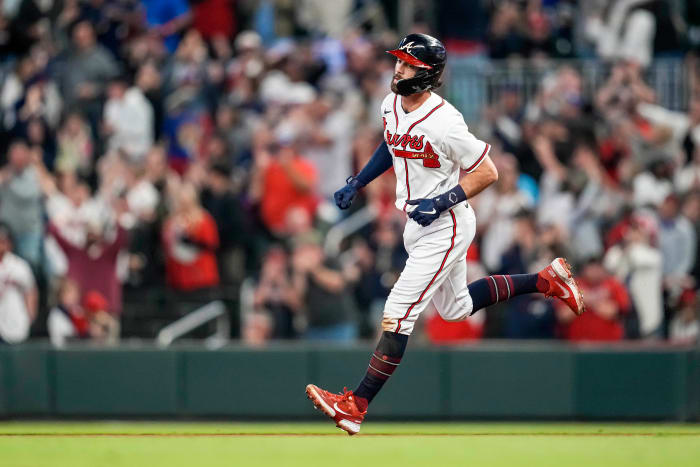
Swanson batted .277/.329/.447 with 25 home runs, 99 runs, 96 RBIs and 18 stolen bases. His 6.4 fWAR ranked second among MLB shortstops, behind Francisco Lindor (6.8).
Dale Zanine/USA TODAY Sports
Let’s move onto the outfield, where Boston needs a fresh face patrolling the area near the Pesky Pole. Late last season, journeyman Rob Refsnyder raked as the Red Sox right fielder—say that five times fast—but the 32-year-old can’t be counted on to replicate his excellent 57-game sample and should instead be viewed as a fourth outfielder going forward. Bloom could very well decide to trade for an upgrade. The Angels’ trade for Hunter Renfroe on Tuesday showed the current going price for a quality right fielder is far from prohibitive.
But with another trade in mind (more on that in a bit), I’m going to hold onto Boston’s prospects and pay up for free agent Mitch Haniger, who’s the best available power-hitting outfielder this side of Aaron Judge. After launching 39 home runs in 2021, Haniger was bothered by an ankle injury for much of last season, but he hit well enough over the season’s final two months to indicate he could still boost a Red Sox offense that was surprisingly short on homers in ’22.
There might be some concern about Haniger’s injury history, because he averaged 106 games in his five full seasons with the Mariners. But only one of those was a soft tissue injury, an oblique strain in early 2017, his rookie year. The series of injuries that forced him to miss the final 115 days of the ’19 season and all of ’20 resulted from one freak play, when he fouled a pitch into his groin and was diagnosed with a ruptured testicle. He underwent an emergency surgery and then tried to return twice that summer but was shut down with discomfort in his core/groin and lower back/sciatic nerve. In January ’20, an MRI of his core revealed an adductor tear/sports hernia from the foul ball. A few days after undergoing surgery for that, he realized his lower back pain wasn’t going away. Another MRI confirmed that he had a herniated disc in his back, and he had another procedure for that. The Mariners shut him down for the pandemic-shortened ’20 season, and he returned at full strength the following year, when he played in 157 games and was one of the best sluggers in baseball.
Excluding 2020, Haniger has averaged 106 games and 21 home runs over the last five full seasons. That’s a pace of 28.8 home runs per 145 games, a reasonable expectation for a player without a history of soft tissue injuries because it allows for one 10-day IL stint and another seven rest days. An All-Star in ’18, Haniger, who is entering his age-32 season, is projected to get four years and $60 million ($15M AAV), so if he keeps his 145-game pace, Boston would get roughly 115 home runs over the length of his deal.
The next area that must be addressed is the rotation, where a minimum of two spots should be filled. Keeping in mind we’ve already signed one player who rejected a qualifying offer in Swanson, that probably rules out Justin Verlander, Jacob deGrom, Carlos Rodón and Chris Bassitt. We could just re-sign some of our free agents, but they didn’t exactly set the world on fire last season, with only 42-year-old Rich Hill posting a FIP below 4.00. And it wouldn’t hurt to gain a compensation pick for letting go of Eovaldi, a 32-year-old with decreasing velocity and durability concerns.
Instead, I’ll turn to Zach Eflin, who is one of the more underrated starters on the market (projected contract: three years, $41.4 million, $13.8M AAV). He wasn’t in the Phillies' rotation during his team’s run to the World Series, but that’s only because he returned from a knee injury late in the season and didn’t have enough time to build up his arm stamina. When the former first-round pick has been healthy, he’s been a rock-solid rotation option. Eflin’s 3.56 FIP this year was better than Bassitt’s, and he’s five years younger. His FIP has been lower than 3.70 in each of the past three seasons, though his surface stats look worse due to Philadelphia’s poor defense. That wouldn’t be as much of a concern with Swanson, Story and Hernández up the middle behind him.
With a little over two-thirds of our $80 million budget spent, it’s time to head to the trade market to add another starter. I used the Baseball Trade Values trade simulator to create a four-player deal that would fill a couple of holes for Boston and send two promising prospects to a rebuilding club in Miami.
Red Sox acquire: SP Pablo López, OF/DH Jorge Soler
Marlins acquire: RHP Connor Seabold, OF Ceddanne Rafaela
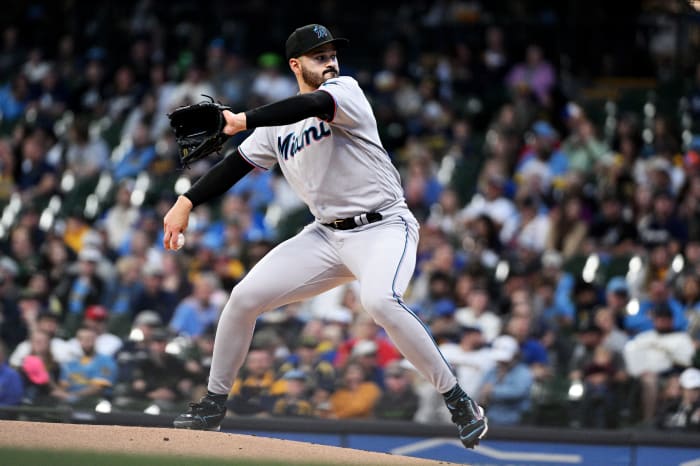
López had a 2.86 ERA over his 18 first-half starts last season, but struggled after the All-Star break (4.97 ERA in 14 starts).
Michael McLoone/USA TODAY Sports
The Marlins dangled López at the deadline but didn’t get any offers to their liking. The price should have come down a bit in the meantime after the righthander faded down the stretch and now has only two seasons of club control remaining. He’d still be a sizable upgrade on anyone currently slated for the Red Sox rotation, though, and would likely command one of Boston’s elite prospects … unless Jorge Soler and the final two years of his three-year, $39 million contract were attached. Soler had a poor debut season in Miami, and GM Kim Ng may want to get out from under his deal to provide payroll flexibility. But the slugger’s light-tower power could easily conquer the Green Monster on a regular basis while he serves as Martinez’s replacement at DH (or at least in a quasi-platoon that’d sit him against tougher righties).
In this scenario, Boston would have to part with one of its top-five prospects in Rafaela, a speedy 22-year-old outfielder who batted .299 with 21 homers in 116 games across High A and Double A in 2022, and another solid prospect in Seabold, who struggled in four games at the big-league level last season but profiles as a back-end starter. Rafaela could feasibly contribute as early as next season, but his approach needs refinement and he’s a better fit for the Marlins’ needs and contention window. Both youngsters are on Boston’s 40-man roster, so the Sox wouldn’t have to designate anyone for assignment to acquire López and Soler.
López is expected to earn $5.6 million next season after arbitration, with Soler getting $12 million. That leaves around $9 million left to augment the bullpen. I might allocate some of that for former Mets setup man Seth Lugo, but Bloom has never been one to spend big on the bullpen and could go any number of directions there. I would love to see Paxton return from Tommy John as an imposing reliever if he no longer can carry a starter’s workload. The 6'4" lefty could be a creative solution to Boston’s closer woes, and entering his age-34 season coming off a Tommy John surgery with just six starts over the last three years, it’d behoove him to limit his innings and perhaps reestablish himself as an elite bullpen arm.
Let’s see where that leaves the projected 25-man roster:
Lineup:
1. Alex Verdugo, LF
2. Dansby Swanson, SS
3. Rafael Devers, 3B
4. Trevor Story, 2B
5. Mitch Haniger, RF
6. Kiké Hernandez, CF
7. Jorge Soler, DH
8. Triston Casas, 1B
9. Reese McGuire, C
Bench:
C: Connor Wong
1B: Eric Hosmer
INF: Christian Arroyo
OF: Rob Refsnyder
Rotation:
1. Chris Sale, LHP
2. Pablo López, RHP
3. Nick Pivetta, RHP
4. Zach Eflin, RHP
5. Brayan Bello, RHP
Bullpen:
John Schreiber, LHP
Matt Barnes, RHP
Tanner Houck, RHP
Seth Lugo, RHP
Garrett Whitlock, RHP
Joely Rodríguez, LHP
Ryan Brasier, RHP
James Paxton, LHP
As for potential Achilles’ heels that were left unaddressed: I’m showing some trust that Casas, the team’s No. 2 prospect, is ready to take over at first base. In 95 plate appearances last season, he graded out as 13% better than the average MLB hitter (113 wRC+) due to 19 walks and five home runs in 95 plate appearances offsetting a sub-.200 batting average. With him, Hosmer and Bobby Dalbec on the 40-man roster, one would hope Boston can cobble enough production there to get by. Bloom has said the catching position isn’t settled, and a reunion with Vázquez could work for all parties involved. But the defensive-minded tandem of Reese McGuire and Connor Wong worked out just fine down the stretch, especially since McGuire mashed after coming over from the White Sox at the trade deadline.
Does the above team make the Red Sox good enough to make the playoffs next season? Possibly, though the AL East is still a gauntlet, even with the more balanced schedule coming in 2023. But this roster would be an improvement over the one they have now. Whatever moves he makes, Bloom better figure out some way to get Boston back to the playoffs. If not, he’ll almost certainly establish a new curse for a franchise very familiar with them: the fourth-year front office firing.
More MLB Coverage:
• Building the Best Blue Jays Team for 2023
• How Banning Infield Shifts Will Change MLB
• Rafael Palmeiro Opens Up About His Steroid-Tainted Legacy
• Astros Owner’s Carelessness Reflected in Insulting Contract Offers
• Ranking MLB’s Top 50 Free Agents, With Signing Predictions































